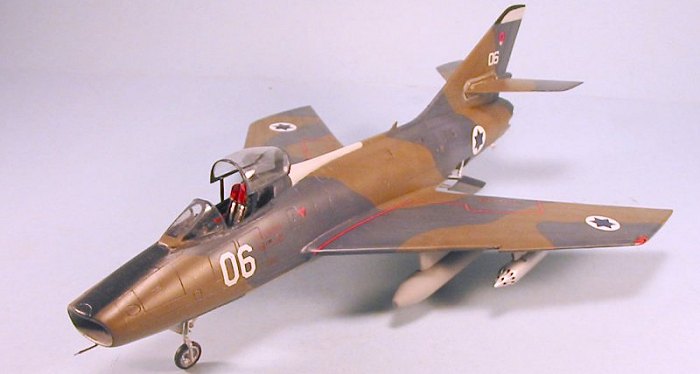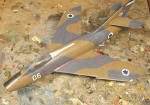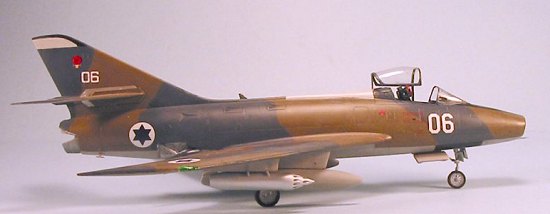
Fonderie Miniature 1/48 Super Mystere B.2
| KIT #: | 6016 |
| PRICE: | $52.95 MSRP |
| DECALS: | Two options |
| REVIEWER: | Tom Cleaver |
| NOTES: | Isradecals #29 used |

| HISTORY |
Dassault’s Super Mystere B.2 was the first western European aircraft capable of supersonic speed in level flight to achieve production status. While the most casual examination of the airplane reveals that Dassault’s design staff were well aware of the existence of the North American F-100 Super Sabre, the fact that they kept the horizontal stabilizer in exactly the wrong position - up on the vertical fin - for supersonic flight ultimately limited the performance of the Super Mystere from what it might have been. This is demonstrated by the fact that, with a similarly-powerful engine, the Super Mystere was approximately 100 m.p.h. slower than its American equivalent.
180 Super Mysteres were produced between 1955-58, 24 of which were sold to the State of Israel in 1957, where they served with distinction until the mid-1970s.
 The first prototype flew with a Rolls-Royce Avon R.A.7R on March 2, 1955,
followed by the first of five Atar-powered pre-production aircraft on May
15, 1976, with the first full production standard aircraft taking to the
air on February 26, 1957. Two examples of the Super Mystere B.4, powered
by an Atar (g and capable of Mach 1.4 in level flight were completed, but
further development was abandoned with the obvious success of the Dassault
Mirage III.
The first prototype flew with a Rolls-Royce Avon R.A.7R on March 2, 1955,
followed by the first of five Atar-powered pre-production aircraft on May
15, 1976, with the first full production standard aircraft taking to the
air on February 26, 1957. Two examples of the Super Mystere B.4, powered
by an Atar (g and capable of Mach 1.4 in level flight were completed, but
further development was abandoned with the obvious success of the Dassault
Mirage III.
The Israeli Super Mystere aircraft equipped the Scorpion Squadron upon their arrival in late 1957, and would serve with this unit during their entire service with the IDF/AF. The aircraft were involved in interceptions of Syrian and Egyptian MiG-17s at various times during the late 1950s and early 1960s, and shot down two Syrian MiG-17s inside Israel in 1961.
With the arrival of the 72 Mirage IIICJs beginning in 1961, the Super Mirage B.2s took on the fighter-bomber role. Israel Aircraft Industries came up with drop tanks of increased size in order to allow the Scorpions to take on the role of long-range strike, in preparation for what would be the resounding Israeli air strike against the Egyptian Air Force on the opening morning of the Six Day War in 1967. Specifically, the Super Mystere B.2s were used in the anti-airfield strikes against Cairo West airfield, the main base of the Egyptian Air Force. During the rest of the war, the aircraft undertook other long-range strike missions against Egyptian Army bases and formations.
On June 8, a flight of Super Mysteres became involved in what is still the
most controversial incident of the war - the Israeli attack on the American
intelligence ship USS Liberty. After the ship was mis-identified as
an Egyptian horse transport, then further mis-identified by the lead pilot
of two Mirage as an Egyptian Hunt-class destroyer, the two Mirages strafed
the ship with 30mm cannon fire, and creating chaos aboard. The Super Mysteres were diverted from a battlefield strike mission, and bombed the
 Liberty with napalm. Charges and counter-charges have passed every
year of the following 37 years as to whether the attack was deliberate.
There are Israeli witnesses who say that it was, while the pilots of the
attacking aircraft have never given testimony. The fact that in a
wide-ranging interview over his career that former Secretary of Defense
Robert S. McNamara - when questioned about the Liberty - replied “I will
not have anything to say about that” has only continued to fuel the
controversy.
Liberty with napalm. Charges and counter-charges have passed every
year of the following 37 years as to whether the attack was deliberate.
There are Israeli witnesses who say that it was, while the pilots of the
attacking aircraft have never given testimony. The fact that in a
wide-ranging interview over his career that former Secretary of Defense
Robert S. McNamara - when questioned about the Liberty - replied “I will
not have anything to say about that” has only continued to fuel the
controversy.
The Super Mystere B.2 remained in first-line service after the Six Day War and took part in long range strike missions in the War of Attrition between 1968-70. In 1968, in attempt to upgrade the performance of the aircraft and get around the French embargo of spare parts, Israel Aircraft Industries undertook to re-engine the surviving Super Mysteres with the J-52 engine used by the A-4 Skyhawk. This was successful, and the first modified aircraft flew in February 1969. Called the Sa’ar, the aircraft was capable of carrying an increased ordnance load. By 1972, all the Super Mysteres had been brought up to Sa’ar standard, distinguished from their original configuration by an extended tail cone. These aircraft undertook their final operational service during the Yom Kippur War in October 1973, and were finally replaced in the mid-1970s.
| THE KIT |
 Only one other kit of the Super Mystere has been produced, a 1/72 model by
Airfix in the mod-1970s. This kit by Fonderies Miniatures was released in
2002. It is a limited-run kit, with the main parts in low-pressure
injection-molded plastic, with a resin cockpit, two vacuformed canopies,
and photo-etch and white metal detail parts. Decals are included for one
French and one Israeli aircraft; these are superior to previous decals from
this company. As is usual with Fonderies Miniatures kits, the plastic
parts do not have a polished surface, and must be sanded smooth prior to
further construction. For a look at what comes in the box, please
visit the preview.
Only one other kit of the Super Mystere has been produced, a 1/72 model by
Airfix in the mod-1970s. This kit by Fonderies Miniatures was released in
2002. It is a limited-run kit, with the main parts in low-pressure
injection-molded plastic, with a resin cockpit, two vacuformed canopies,
and photo-etch and white metal detail parts. Decals are included for one
French and one Israeli aircraft; these are superior to previous decals from
this company. As is usual with Fonderies Miniatures kits, the plastic
parts do not have a polished surface, and must be sanded smooth prior to
further construction. For a look at what comes in the box, please
visit the preview.
| CONSTRUCTION |
I have to admit up front, I was not anxious to do this model when it first came out, due to the really bad experiences I had had with the Mystere IVA, and Fouga Magister kits from this company, and also the Vautour designed by F-M for Hi-Tech. In those kits, nothing went together right, and the models were impossible to build without a dremel tool to ream out the fuselage halves and grind down the resin interior detail parts in order to get things to fit. It was only when I heard from another modeler that this one wasn’t like those that I decided to pluck the sad little kit from its dust-gathering place on the shelves of the local hobby shop where it had been since its arrival two years ago.
Surprise surprise! My friend was right!!
 While the plastic parts still needed sanding down to get a smooth surface,
test-fitting of the resin cockpit and the wheel wells revealed that they
were actually designed to fit inside the fuselage shell! Not only that,
but the upper and lower wing halves were of similar dimensions, and the
horizontal stabilizers were also right. In fact, the model went together
in a very straightforward manner with careful test-fitting in two long
afternoon sessions over a quiet weekend, using only Mr. Surfacer 500 on the
various seams, which then politely disappeared with some sanding-down. The
only area that really created any fit problem was the nose cone, which also
includes the air intake. I blocked off the intake with evergreen sheet,
and then put fish weights in the nose and beneath the cockpit to either
side of the nose wheel well to insure nose-sitting. I was definitely
impressed by the overall improvement in production design quality at this
point as I polished the model with Tamiya plastic polish and was ready for
the paint shop.
While the plastic parts still needed sanding down to get a smooth surface,
test-fitting of the resin cockpit and the wheel wells revealed that they
were actually designed to fit inside the fuselage shell! Not only that,
but the upper and lower wing halves were of similar dimensions, and the
horizontal stabilizers were also right. In fact, the model went together
in a very straightforward manner with careful test-fitting in two long
afternoon sessions over a quiet weekend, using only Mr. Surfacer 500 on the
various seams, which then politely disappeared with some sanding-down. The
only area that really created any fit problem was the nose cone, which also
includes the air intake. I blocked off the intake with evergreen sheet,
and then put fish weights in the nose and beneath the cockpit to either
side of the nose wheel well to insure nose-sitting. I was definitely
impressed by the overall improvement in production design quality at this
point as I polished the model with Tamiya plastic polish and was ready for
the paint shop.
| COLORS & MARKINGS |
Painting:
 After pre-shading the model, I painted the “second scheme” camouflage,
using Tamiya Sky Grey for the lower surface, and Gunze-Sangyo British Dark
Earth and Navy Blue for the upper surface colors. The Isradecal sheet -
which I highly recommend for its thorough information on the paint schemes
for this airplane - stated that these colors were all “hard-edged,” so I
masked them using drafting tape and running thread 1/16" in from the edge
of the mask to lift the edge and avoid a paint ridge when applying the
second color. The photographs in the decal sheet of the airplanes during
the Six Day War showed them with only light sun-fading and otherwise quite
clean.
After pre-shading the model, I painted the “second scheme” camouflage,
using Tamiya Sky Grey for the lower surface, and Gunze-Sangyo British Dark
Earth and Navy Blue for the upper surface colors. The Isradecal sheet -
which I highly recommend for its thorough information on the paint schemes
for this airplane - stated that these colors were all “hard-edged,” so I
masked them using drafting tape and running thread 1/16" in from the edge
of the mask to lift the edge and avoid a paint ridge when applying the
second color. The photographs in the decal sheet of the airplanes during
the Six Day War showed them with only light sun-fading and otherwise quite
clean.
Decals:
I used the Isradecals, which are excellent quality, to do Super Mystere 06 of the Scorpion Squadron. The sheet also provides Hebrew stenciling for the aircraft in addition to the national and squadron markings. The decals went down with no problem using a coat of Micro-Sol.
| FINAL CONSTRUCTION |
 The camouflage paint scheme is overall gloss, which had dulled in the three
years since it was first applied prior to the Six Day War, so after giving
the model a second coat of Future, I applied a thin coat of Dullcote, which
resulted in a “satin” finish.
The camouflage paint scheme is overall gloss, which had dulled in the three
years since it was first applied prior to the Six Day War, so after giving
the model a second coat of Future, I applied a thin coat of Dullcote, which
resulted in a “satin” finish.
The kit comes with only the large drop tanks, and no underwing ordnance. The drop tanks are big enough to present some clearance problems with the landing gear. Since the Eduard Mirage III had arrived in the meantime, I decided to use the “subsonic” drop tanks from this kit - which are also right for the Super Mystere - and the rocket packs to arm the model as it would have been during the Six Day War.
Since the cockpit is nicely detailed, I decided to cut open the canopy and attach it in the raised position.
| CONCLUSIONS |
To me, Marcel Dassault is the best French aircraft designer in the years after the Second World War. All of Dassault’s jets are good-looking airplanes, and the Super Mystere is no different. The essential “rightness” of the design is shown by the fact that it still flies on in the form of the Super Etendard and Dassault Falcon business jets, which closely follow the shape of the Super Mystere. This kit is not the monster one expects by reputation from Fonderies Miniatures, and a modeler with a couple limited-run kits successfully accomplished should have no problem turning out a good-looking model from this kit.
August 2004
Copyright Modeling Madness.com.
Review kit courtesy of my wallet.
If you would like your product reviewed fairly and fairly quickly, please contact the editor or see other details in the Note to Contributors.